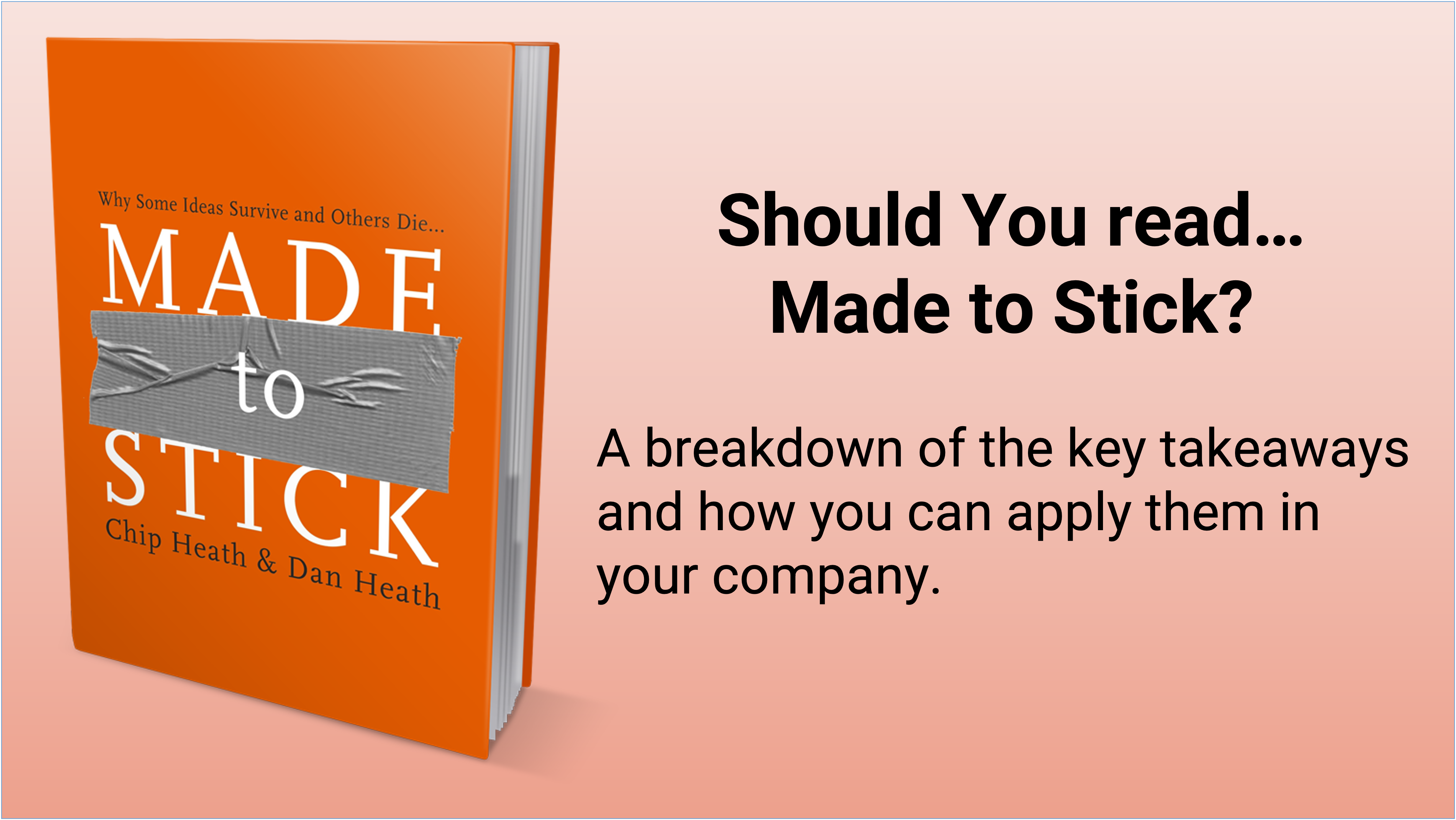Authors – Chip & Dan Heath
Publication Date – September 2008
Links to Buy – US Amazon, Europe Amazon
One Minute Manager Summary
Video Preview
One Minute Manager Summary
Why YOU should read this book
Made to Stick is one of my favorite books when it comes to communication, especially when it comes to creating compelling visions or motivating stories. At its core, Made to Stick is a guide on how to design your communication in a way that will make your ideas stick in the heads of the audience. By following the takeaways in Made to Stick, your will present your ideas in a way so that they will be understood, remembered, and have a lasting impact.
The skills discussed in Made to Stick are essential to a founder or any leader of a startup. Sometimes I think that 90% of the job of a founder/leader is to communicate ideas in a way that leads to people taking a desired action. In that manner, the skills in this book can be used in many different situations. You can use them to improve your sales and marketing communications, so your value propositions stick in the heads of your customers. You can use these skills to motivate the actions of your employees or key partners. You can even use these skills to create visionary presentations that can use with your investors.
Made to Stick Summary
Key Takeaways
There are 6 principles of “stickiness” that you can use to make your ideas and communications more effective. Made to Stick uses the mnemonic SUCCES(s)
1) Simplicity – Simplicity is about finding the essential core of your idea. It isn’t about dumbing down your idea, but instead it is about prioritizing what you say. If you have 10 points – even though they are all excellent points – no one will be able to remember all 10. Instead of overwhelming your audience with information you need to keep things simple and to the point. How do we find the essential core of our ideas? Simplicity isn’t about dumbing down, it’s about prioritizing.
2) Unexpectedness – It is important to get an audience to pay attention to our ideas and maintain their interest. To do that it is important to surprise them. Now I don’t mean to jump out from behind a bush. Instead, you should surprise them by identifying gaps in their knowledge, and then help them fill those gaps. By learning something unexpected, a person’s brain jolts out of autopilot, and they start paying attention.
3) Concreteness – Your idea needs to be clear and understandable. Our brains are hardwired to understand concrete things like facts and figures, and can struggle with things like theoretical concepts. So when presenting your idea, present the concrete data that supports your idea.
4) Credibility – Ideas only spread if they are believed. If not, they are dismissed without further ado. But how do we make people believe in our ideas? The answer is simple. We make them credible, authentic and believable.
5) Emotions – While people have an easier time understanding concrete data, data alone won’t inspire action. Motivating people to do something requires more than data. It requires that they feel something. Tell them why your idea can help them by using the “What is in it for you” angle. And remember people care about people, nut numbers.
6) Stories – Finally, it is important to remember that humans evolved by communicating through stories. History, religion, morality, and many more topics were taught through storytelling. And it makes sense, because stories are memorable, they convey wisdom concisely, and are easily reshared with others. So make sure you tell stories in your communications (either real life stories or ‘fables’ that can highlight your company’s values).
Made to Stick Summary
How YOU can apply the key takeaway
Part of the reason I love Made to Stick, is that the core takeaways can be immediately applied. We recommend starting by reviewing some of your previous presentations or communications. Was your communication focused on one idea (Simplicity) and were you able to surprise your audience with some previously unknown fact (Unexpectedness)? Did your communication present clear and concrete ideas (Concreteness) in a way that built your credibility (Credibility)? Were you able to use storytelling (Stories) and connect with the emotions of your audience (Emotions)?
By answering questions like this, you will be able to know your current ability to deliver “sticky” communications, and knowing your current state will help you in building a plan to improve. While there are some ways you can improve your communication on your own, the easiest way to get better is to enlist the help of others. For some of you that might mean attending a communications training program, but it doesn’t have to be that complex. The most effective way to make your communications more sticky is to get feedback from a trusted colleague. Walk through different options for your communication, and see what resonates most with that person.
Made to Stick Summary
Cary Bailey–Findley has built High Performance Cultures within three Fortune 500 companies, and was awarded the ranking of #1 development organization in the world by the Association of Talent Development. He is currently the Talent Manager for SimCorp, but spends his free time helping startups scale up the the talent they need to succeed.





Add a Comment